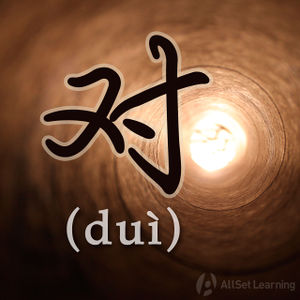Comparing "gen" and "dui"
-
Level
-
Similar to
-
Used for
-
Keywords
跟 (gēn) and 对 (duì) sometimes seem like they mean the same thing, and at other times they seem to be different. You need to be aware which cases are which.
Contents
When they have the same form and same meaning when used with 说
When using the verb 说, 跟 and 对 can both be used in a similar sentence pattern. 跟 and 对 are both prepositions, and they both express one person speaking to another.
Structure
Person A + 跟 / 对 + Person B 说
Examples
- 我 跟 她 说 了,但是 她 不 信。I told her, but she didn't believe me.
- 我 对 她 说 了,但是 她 不 信。I told her, but she didn't believe me.
- 他 对 我 说 他 爱 我。He told me he loved me.
- 他 跟 我 说 他 爱 我。He told me he loved me.
- 刚才 你 对 他 说 什么 了?What did you just tell him?
- 刚才 你 跟 他 说 什么 了?What did you just tell him?
When they have a similar grammar structure but different meanings
跟 and 对 can be verbs, and they often are used with a 着, however their meanings are different.
Structure
Subj. + 跟 / 对 + Obj.
Examples for 跟
跟 is a verb, and it's simplest meaning is "follow." Often it is used as a verb phrase, such as 跟着, 跟上, 跟不上, 跟得上, 跟somebody + Verb.
- 这 只 小 猫 总是 跟着 我。This little cat always follows me.
- 你 走 得 太 快 ,我 跟不上。You walk too fast, I can't keep up.
- 你 想 跟 我 去 吗?Do you want to go with me?
Examples for 对
对 is also a verb, put it has the meaning of "towards" or "point to." Often it is used as: 对着, 对上, 对不上.
- 枪口 不 要 对着 人。Don't point guns at people.
- 我 喜欢 对着 镜子 笑。I like to laugh at myself in the mirror.
- 这 两 本 账 对不上。These two accounts don't match up.
When to use 跟 and not 对
跟 is a proposition, and it can be used in comparison. It will often have a supplementary explanation, similar to how 和 can be used (as in 我和你一样高). 对 cannot be used this way.
Structure 1
This structure is used to explain that two things are (or aren't) similar.
A + 跟 + B + (不)一样
Examples
- 我 跟 你们 不一样,我 还 有 孩子 呢。I am not like you guys. I still have kids.
- 上海 跟 纽约 一样,都 是 国际 大 都市。Shanghai and New York are alike; they are both international cities.
Structure 2
This structure shows that two nouns are the same in some some aspect, which is the word that follows "一样."
A + 跟 + B + (不)一样 + Adj.
Examples
- 我 现在 跟 我 爸 一样 高。Now I'm as tall as my dad.
- 你 跟 你 妈 一样 喜欢 买 衣服。You like to buy clothes just like your mother.
Structure 3
"跟" functions as a conjunction in this structure, joining two things together. Generally, these are nouns or pronouns (as with "和"). "对" cannot function like this.
Subj. 1 跟 Subj. 2 + Verb-Obj.
Examples
- 你 要 跟 我 一起 去 吗?Are you going to go with me?
- 鲜花 跟巧克力 是 最 好 的 礼物。Flowers and chocolate are the best gifts.
Examples when to use 对 and not 跟
Structure
When 对 as a proposition, it points to a certain target,since it can mean "point to" or "toward to." 跟 can only be used this way with 说.
Subj. 1 对 Subj. 2 + Verb
Examples
- 那 个 美女 正 对 我 笑 呢。That pretty girl is laughing at me.
- 不 要 对 老板 发脾气, 不然 后果 很 严重。Don't lose your temper with the boss, otherwise there will be serious consequences.
Example Dialog
- A: 那 个 帅哥 在 对 我 招手!That handsome guy is motioning for me to go to him!
- B: 那 你 要 跟 他 去 吗?Well, are you going to go with him?
See Also
Sources and further reading
Books
- 现代汉语八百词(增订本) (pp. 201) [ →buy]
Dictionaries
- 现代汉语词典(第5版) (pp. 465, 343) 卓越汉语-公司实战篇 →buy



